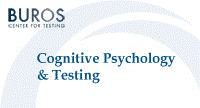Buros-Nebraska Series on Measurement and Testing

The Influence of Cognitive Psychology on Testing
Date of this Version
1987
Document Type
Article
Citation
From The Influence of Cognitive Psychology on Testing, edited by Royce R. Ronning, John A. Glover, Jane C. Conoley, and Joseph C. Witt (Hillsdale, NJ: Lawrence Erlbaum Associates, 1987)
Abstract
Subject Index- 10 pages
A-Z
A
Ability, see also specific type classes of, Cattell-Horn model and, 15 definition of, 268- 274 exceptional, acquired skill vs., 216-221 fluid and crystallized, correlation of, 96- 97 measurement of, 87-88, 267- 283 cognitive ability factors and, 280- 282 definition s and, 268-274 person characteristic function and, 275-279 task difficulty and, 279-280
Academic abilities, 145-183 cognitive strategies and, 150-152 control processes and, 149-150 declarative knowledge and, 146- 148 factors in, 146 in mathematics, 175-179 metacognition and, 152- 153 procedural knowledge and, 148-149 in reading, 153-162, see also Reading in science, 179- 182 in writing, 163-175, see also Writing
Achievement assessment, 41-81 automaticity and, 44- 45 expert performance and, 49-50 general dimensions for, 77-81 intelligent tutoring systems and, 69-76, see also Intelligent tutoring systems knowledge structures and, 43-44 mental models of, 50-52 metacognitive skill s and, 49 practice and, 46-48 proceduralization and, 45-46 proximal development zone and, 48 psychology of learning and, 43 self-regulatory skills and, 49 subject matter acquisition and, 52-60, see also Subject matter acquisition; specific subject testing methodology and, 60-69, see also Testing methodology
Adaptive instruction, tutor architectures and,70- 71
ADCLUS, 231
ADDTREE music perception and, 240 underlying representation and, 248- 249
Age, metacognition and, 152
Anderson's associa tive theories, 256
Appearance models, 51, 52
Aptitude layer of knowledge, intelligent tutoring systems and, 74-75
Aptitude-treatment interaction research, 145
...
Z
Zone of proximal development, 48


Comments
Copyright © 1987 Lawrence Erlbaum Associates, Inc. Digital Edition Copyright © 2012 Buros Center for Testing.